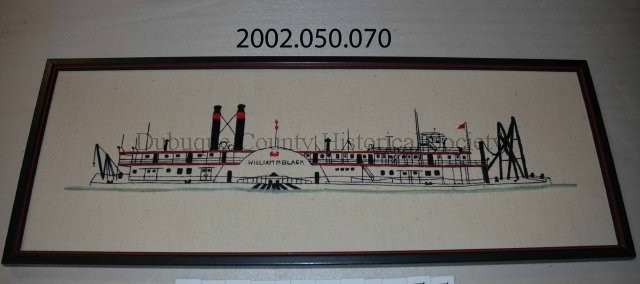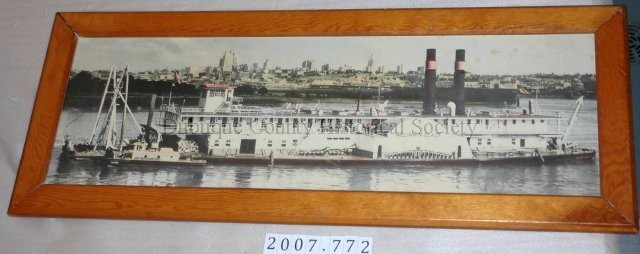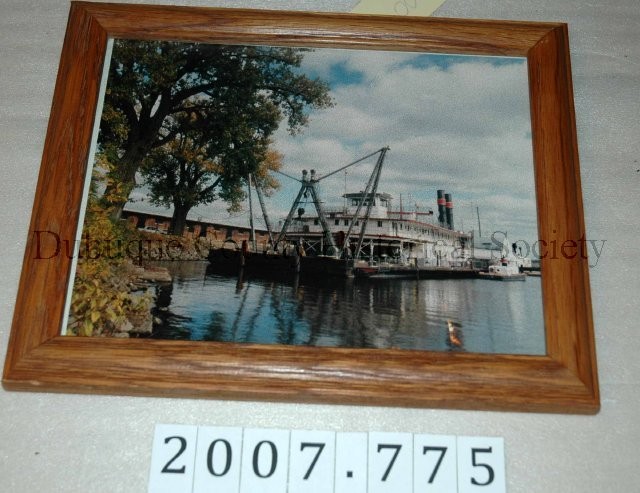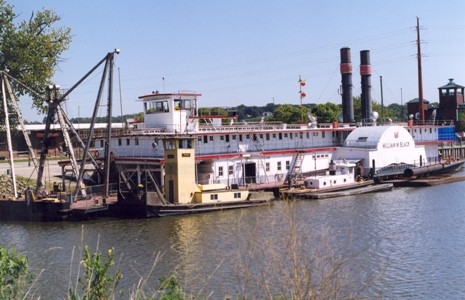William B. Black (Dredge)
Introduction
Text-to-speech Audio
Images
Picture, Needlework, Framed cross stich piece of the the dredge steamboat the William M. Black. Accession 2002.02.0070 Courtesy of National River Museum and Aquarium Archives

Print, Photographic, Colorized Black and white photograph of the dredge William M. Black. Accession 2007.772 Courtesy of National River Museum and Aquarium Archives

Print, photographic, Colored photograph of the dredge William M. Black. The boat is docked with a small tugboat to the right. Accession 2007.775 Courtesy of National River Museum and Aquarium Archives

Courtesy of National Mississippi River Museum and Aquarium

Backstory and Context
Text-to-speech Audio
During the late 1700s, immigrants reached the west through river transportation and, as more people began traveling west, larger boats were needed. The first steamboat was built in 1811 by Robert Fulton and revolutionized river transportation [1]. Steam power was inexpensive and allowed goods to be transported easily. [2]
Dredges developed as a means to “…deepen and widen navigable waterways”. [3] Dredges used open-ended pipes to suction sediment from the bottom of the river and deposit it elsewhere. The William B. Black is one of only three surviving “dustpan dredges”. Dustpan dredges, “named for the shape of their suctionhead, used a wide suction head to pick up sediment…” [4]
The U. S. Army Corps of Engineers was responsible for improving irrigation, flooding, and navigation on the Western Rivers. In the 1930s “the Corps began an ambitious project to control the mighty Missouri River by lengthening and improving the navigable water route to the Mississippi… by creating a nine-foot deep main channel.” [5] The William B. Black was one of four “super dredges” designed to make the Missouri River more navigable.
In 1934, the Marietta Manufacturing Company of Point Pleasant, West Virginia won the bid to build two dredges for the U.S. Army Corps of Engineers. The William B. Black was launched on September 1, 1934. It was named after Major General William Murray Black, Chief of Engineers during World War 1. Before being delivered to the Corps, the William B. Black was used to pump water into a fire at the Point Pleasant Transportation Company. [6]
The William B. Black was a hydraulic powered dredge that used a “…vacuum-cleaner like dustpan head on the end of a 34 inch intake pipe that was lowered to the river bottom”. [7] The water and sediment was piped through a 500-foot pipe held up by barges and deposited on the riverbanks. The pump was powered by a “triple expansion steam engine”. [8]
Sixty crewmembers operated and lived on the William B. Black. [9] The William B. Black set a world record in 1935 for most material dredged in 29 days. [10] The William B. Black continued to dredge the Missouri, contributing to it’s completion fifteen years after it began. The William B. Dredge survived thunderstorms, hurricanes, collisions, and damage from ice throughout her career.
The William B. Black was decommissioned in 1973 and was given to the historical society in Dubuque, Iowa. Then in 1979, “…the General Services Administration deeded the dredge to the Dubuque County Historical Society for use as a museum ship…” [11] The dredge was moved to Ice Harbor and opened as a museum in 1980.” [12]
